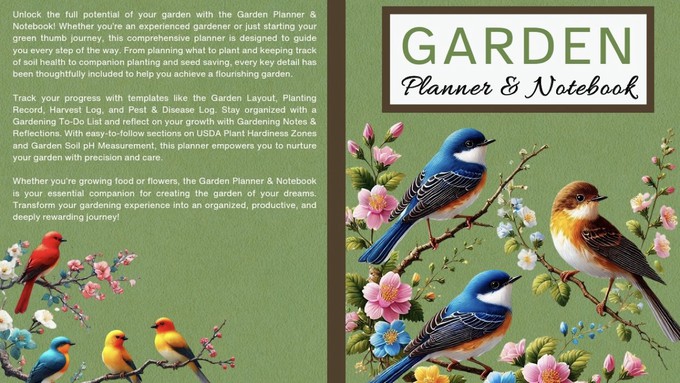
Sacramento gardener creates notebook to make detailed record-keeping simpler

Rena Rodgers of Sacramento designed this Garden Planner & Notebook and included all kinds of information especially useful to the beginning gardener. Courtesy Rena Rodgers
Have your New Year’s garden resolutions gotten sidetracked? This handy planner will get you back on track – just in time for planning your spring and summer gardens.
“Garden Planner & Notebook,” created and self-published by Sacramento gardener Rena Rodgers, lets gardeners compile up to five years' worth of observations and important information in one place. This attractive 150-page paperback is generously sized – 8-1/2 by 11 inches – with wide spaced lines (enough room to actually write more than a few words). And the price is right: $12.99 plus tax and shipping via Amazon.
Well organized, the planner takes both novice and experienced gardeners through the seasonal process: Accessing your resources (including setting budgets for money and time), deciding what to plant (what are your family’s favorite vegetables, fruit, herbs and flowers?), creating a general overview for the year and mapping out garden layouts.
There are also plenty of pages for to-do lists and invaluable plant-by-plant planting records, requesting information that could play a huge role in gardening success. Besides planting date and expected harvest, it prompts details on weather (average high and low temperatures on planting date), if the plant was grown from seed or transplant and other information you wish you had written down.
There are logs for harvest, pests and disease (including treatment) and fertilization plus plenty of room for random thoughts. It’s the kind of planner that inspires action and observation.
Before getting into the note-taking, this planner features helpful reminders to consider before digging in, such as hardiness zones, soil health (have you tested your backyard’s pH lately?), companion planting and “Gardening Golden Rules” (such as “Sunlight is the lifeblood of your garden” and “Water is vital for all living things”). The information is pretty basic, but solid, especially if starting a garden from scratch.
Gardening for relaxation, Rodgers used her own experience to create the planner she wished she had when she started her hobby. She uses her own planner now and says it has helped her stay focused and keep her vegetable garden on track.
“Whether you’re a seasoned gardener or just starting your green-thumb journey, the ‘Garden Planner & Notebook’ is your essential companion for cultivating a beautiful and productive garden year after year,” Rodgers says in her introduction. “This comprehensive 5-year planner is designed to help you organize, track, and grow your garden with ease and confidence.”
“Garden Planner & Notebook” is available from Amazon: https://www.amazon.com/Garden-Planner-Notebook-Planning-Reflecting/dp/B0DH8G1DK8
Comments
0 comments have been posted.Sacramento Digs Gardening to your inbox.
Food in My Back Yard Series
May 6: Maintain soil moisture with mulch for garden success
April 29: What's (already) wrong with my tomato plants?
April 22: Should you stock up on fertilizer? (Yes!)
April 15: Grow culinary herbs in containers
April 8: When to plant summer vegetables
April 1: Don't be fooled by these garden myths
March 25: Fertilizer tips: How to 'feed' your vegetables for healthy growth
March 18: Time to give vegetable seedlings some more space
March 11: Ways to win the fight against weeds
March 4: Potatoes from the garden
Feb. 25: Plant a fruit tree now -- for later
Feb. 18: How to squeeze more food into less space
Feb. 11: When to plant? Consider staggering your transplants
Feb. 4: Starting in seed starting
Sites We Like
Garden Checklist for week of May 11
Make the most of the lower temperatures early in the week. We’ll be back in the 80s by Thursday.
* Plant, plant, plant! It’s prime planting season in the Sacramento area. Time to set out those tomato transplants along with peppers and eggplants. Pinch off any flowers on new transplants to make them concentrate on establishing roots instead of setting premature fruit.
* Direct-seed melons, cucumbers, summer squash, corn, radishes, pumpkins and annual herbs such as basil.
* Harvest cabbage, lettuce, peas and green onions.
* In the flower garden, direct-seed sunflowers, cosmos, salvia, zinnias, marigolds, celosia and asters. (You also can transplant seedlings for many of the same flowers.)
* Plant dahlia tubers.
* Transplant petunias, marigolds and perennial flowers such as astilbe, columbine, coneflowers, coreopsis, dahlias, rudbeckia and verbena.
* Keep an eye out for slugs, snails, earwigs and aphids that want to dine on tender new growth.
* Feed summer bloomers with a balanced fertilizer.
* For continued bloom, cut off spent flowers on roses as well as other flowering plants.
* Add mulch to the garden to maintain moisture. Mulch also cuts down on weeds. But don’t let it mound around the stems or trunks of trees or shrubs. Leave about a 6-inch-to-1-foot circle to avoid crown rot or other problems.
* Remember to weed! Pull those nasties before they set seed.
* Water early in the day and keep seedlings evenly moist.